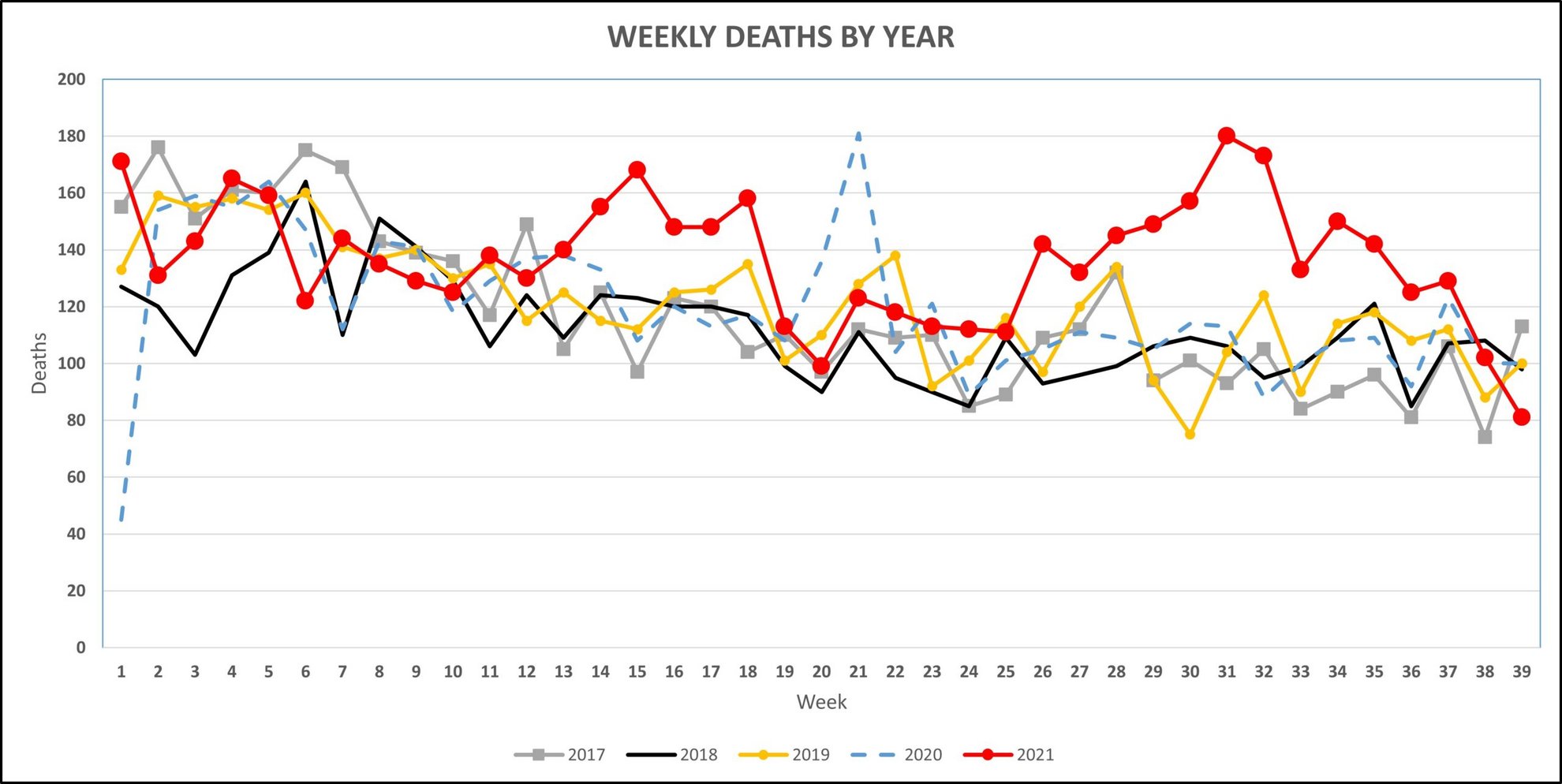Covid-19 obviously explains some, but by no means all
More people have died in the Republic of Cyprus in 2021 than in previous years, and no-one is entirely sure why.
The week-by-week numbers on Eurostat up to the end of September, i.e. the first three quarters of the year – later weeks weren’t yet available at time of writing – paint a sobering picture.
There have been 5,338 deaths in the first three quarters of 2021. The corresponding figures for the previous four years are 4,650 (for 2020), 4,719 (2019), 4,368 (2018) and 4,607 (2017). The figures for 2020 and 2021 are provisional, but the signal is worrying: we’ve had almost 1,000 more deaths this year than in the equivalent period in 2018.
Much of that is Covid, of course. In the period from January 1 to September 30, 427 people are reported to have died either from, or with, the virus (it’s no longer specified which). Even if all those people were deducted, however – which would be flat-out wrong, since Covid preys disproportionately on the old and immunocompromised so at least some of those 427 would’ve been near the end of life anyway – the total for 2021 would still be excessive.
George Melas, who has run G&P Melas Funeral Directors in Nicosia with his brother Pavlos since 2010, agrees that this year has been “the highest ever”.
“In the past 10 years, this is definitely the highest amount of deaths,” he told the Cyprus Mail. “Not only that we’ve handled, but also that we’ve had in Cyprus.”
Other funeral homes report the same thing, according to Melas. “All of my colleagues are handling more funerals this year than other years. All of them.”
Nor is the problem confined to Cyprus. “It’s also in the UK, my colleagues tell me the same story… All of my colleagues that I’ve talked to, everybody – from the United States, to the UK, to Hungary, Greece, Italy, Belgium, they’re all faced with an increased number of deaths.”
The UK has indeed recorded high excess mortality this year. “Since early July,” wrote the Financial Times on November 23 (‘UK enters wave of excess deaths not fully explained by Covid’), non-Covid deaths “have been higher than the weekly average for the five years leading up to the pandemic”.
In Cyprus, says Melas, there was an unusually high number of people dying at home. “At the beginning of the year, every night almost, we were collecting deceased from homes. January, February, March, April…”
The pattern – though not the overall picture – then changed slightly. “We didn’t have a lot of people dying at home during the summer… But the amount of funerals [relative to previous years] continued to increase.”
Okypy spokesman Charalambos Charilaou had no comment when approached by the Cyprus Mail, arguing that it wouldn’t be right to draw any conclusions till the figures are fully updated with causes of death and so on. Unfortunately, that takes time; the figures for 2019 were only completed a couple of months ago.
For what it’s worth, Melas says he hasn’t noticed anything unusual regarding causes of death; it’s much the same mix as before, only at elevated numbers. He also hasn’t noticed a higher proportion of younger people dying – though some of his colleagues, he admits, “say they’ve been handling more young people’s funerals”.
His explanation for the increase in deaths is simple: “All these deaths are the collateral damage of the pandemic”.
People die at home, he says, because fear of Covid means they don’t go into hospital for a condition that might otherwise be treatable. Even when they do, beds might not be available due to Covid patients. What’s more, “the quality of healthcare we’ve been receiving has gone down, big-time”. The system is overloaded, and hospital staff understandably exhausted.
This is plausible – yet the week-by-week data complicates matters.
Despite Melas’ assertion that numbers have been consistently high throughout the year, a look at the data [see graph] shows that 2021 has been largely within normal parameters – with two big exceptions.
The increase in deaths is largely due to two massive surges: the first one from Week 14 to Week 18 (basically April and the beginning of May), the second, even bigger one from Week 26 all the way to Week 35 (end of June, July and August). These of course coincide with our third and fourth waves of Covid – yet the numbers are dramatically higher.
Week 31, for instance, saw 180 deaths, massively higher than last year’s 113 (which itself was quite high). Yet only 17 Covid deaths were recorded during that week.
This is puzzling. If the reason for this year’s excess is the ‘lockdown effect’ of people not being treated in time for treatable conditions, one would expect to see slightly higher numbers across the board, not a couple of big spikes.
It’s quite possible, of course, that – once a Covid wave actually hits – people are afraid, or unable, to go into hospital, so these deaths are indeed collateral damage as suggested by Melas.
But, in that case, one would expect to see the same effect taking place during our second wave in winter 2020/21 – which, after all, was as big as the later ones in spring and summer. (The first wave, right at the beginning of the pandemic, was tiny by comparison.) Yet the data shows no significant excess for January, when hospitalisations and deaths were at their peak.
The second week of 2021 was actually the deadliest of the whole pandemic, with 26 Covid deaths – yet total deaths were 131, lower than average.
This raises the obvious possibility that the excess may be related to the vaccines – since, after all, the second wave (no excess) was pre-vax whereas the third and fourth waves (big excess) were post-vax.
It would certainly be big news if vaccination could be shown to be responsible for excess deaths, especially given the growing evidence that adverse effects aren’t as rare as originally claimed. Yet the data doesn’t really gel with that explanation, either.
Our vaccination programme got going in January and February, really picked up speed in late April (around the time of the second full lockdown) and picked up again in July, driven by fear and high case numbers – but it’s actually proceeded at quite a steady pace. There have been no sudden surges in vaccination rates, let alone surges that correlate to the two big mortality spikes.
Indeed, deaths plunged significantly from about Week 20 to Week 25 (late May and June), decreasing to average levels for the time of year. Yet thousands of people continued to get vaccinated during those weeks.
The best explanation – leaving aside the possibility that Covid is actually much worse than we’re being told, causing lots of unrecorded deaths in addition to recorded ones – may in the end be the hospital theory, viz. that non-Covid patients are unable to go into hospital or receive adequate healthcare once Covid hits.
It’s notable, for instance, that excess deaths seem to peak just when hospitals are fullest (and before the peak in Covid deaths). Week 31, with those 180 deaths, was the first week of August, with a record 301 hospitalisations; five weeks later, Covid deaths were high but the pressure on hospitals had abated, and total deaths declined to 125.
It’s also notable that the second wave in winter – despite high mortality – never filled hospitals quite as badly as the ones in spring and summer, with a peak of 208 patients, which might explain why it didn’t translate into high excess deaths like those later ones did.
In the end, the fact that our government (like most European governments) made no concerted effort to support hospitals in the past 20 months may be the biggest scandal of this whole pandemic.
One can only speculate how many of these excess deaths could’ve been avoided if we’d found ways to increase capacity – an option that was quickly dismissed as impossible and never properly investigated, even as ‘impossible’ lockdowns became totally possible – or, even more, if we’d tried to break the link between Covid and hospitalisation by urging people to bolster their immune system and supplying early treatment, at home, with already-existing drugs (ivermectin and fluvoxamine are perhaps the best known, but there are others) which have shown promising results in other countries. Again, this course of action was dismissed as mere quackery, never explored or even attempted, even as hospitals filled up and non-Covid deaths soared.
The ‘collateral damage’ theory is probably the one that best fits our data – yet the sheer number of excess deaths remains surprising. Can there really have been so many critically ill non-Covid patients deprived of a hospital bed – in mid-summer, no less, and without tourists to pad out the numbers – to result in 353 deaths within a fortnight (Weeks 31 and 32), when the usual number is about 200? Numbers don’t lie, yet it still seems extraordinary.
Was there some reporting lag? Might the numbers have been bunched up in some way? And how does all this square with George Melas’ experience of consistently higher deaths since the beginning of the year?
Ultimately, we can only go back to the observation that kicked off this article. More people died in 2021 than in previous years – not just in Cyprus, but all over Europe and the US – and no-one is entirely sure why.








Click here to change your cookie preferences